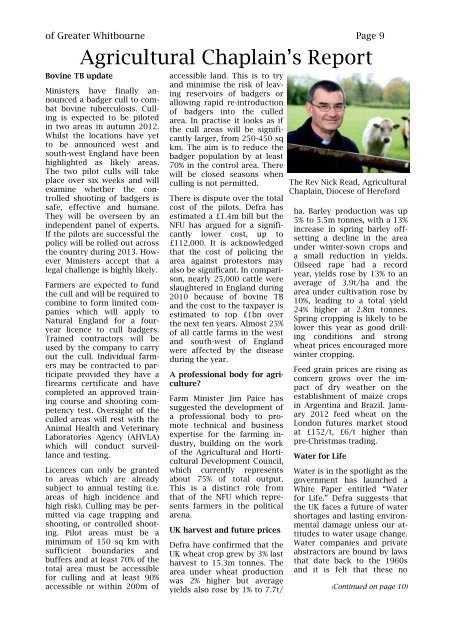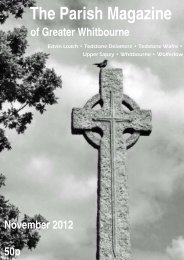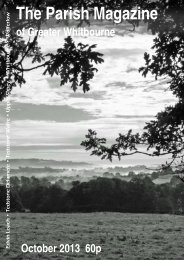The Parish Magazine - Parish of Greater Whitbourne
The Parish Magazine - Parish of Greater Whitbourne
The Parish Magazine - Parish of Greater Whitbourne
You also want an ePaper? Increase the reach of your titles
YUMPU automatically turns print PDFs into web optimized ePapers that Google loves.
<strong>of</strong> <strong>Greater</strong> <strong>Whitbourne</strong>Bovine TB updatePage 9Agricultural Chaplain‘s ReportMinisters have finally announceda badger cull to combatbovine tuberculosis. Cullingis expected to be pilotedin two areas in autumn 2012.Whilst the locations have yetto be announced west andsouth-west England have beenhighlighted as likely areas.<strong>The</strong> two pilot culls will takeplace over six weeks and willexamine whether the controlledshooting <strong>of</strong> badgers issafe, effective and humane.<strong>The</strong>y will be overseen by anindependent panel <strong>of</strong> experts.If the pilots are successful thepolicy will be rolled out acrossthe country during 2013. HoweverMinisters accept that alegal challenge is highly likely.Farmers are expected to fundthe cull and will be required tocombine to form limited companieswhich will apply toNatural England for a fouryearlicence to cull badgers.Trained contractors will beused by the company to carryout the cull. Individual farmersmay be contracted to participateprovided they have afirearms certificate and havecompleted an approved trainingcourse and shooting competencytest. Oversight <strong>of</strong> theculled areas will rest with theAnimal Health and VeterinaryLaboratories Agency (AHVLA)which will conduct surveillanceand testing.Licences can only be grantedto areas which are alreadysubject to annual testing (i.e.areas <strong>of</strong> high incidence andhigh risk). Culling may be permittedvia cage trapping andshooting, or controlled shooting.Pilot areas must be aminimum <strong>of</strong> 150 sq km withsufficient boundaries andbuffers and at least 70% <strong>of</strong> thetotal area must be accessiblefor culling and at least 90%accessible or within 200m <strong>of</strong>accessible land. This is to tryand minimise the risk <strong>of</strong> leavingreservoirs <strong>of</strong> badgers orallowing rapid re-introduction<strong>of</strong> badgers into the culledarea. In practise it looks as ifthe cull areas will be significantlylarger, from 250-450 sqkm. <strong>The</strong> aim is to reduce thebadger population by at least70% in the control area. <strong>The</strong>rewill be closed seasons whenculling is not permitted.<strong>The</strong>re is dispute over the totalcost <strong>of</strong> the pilots. Defra hasestimated a £1.4m bill but theNFU has argued for a significantlylower cost, up to£112,000. It is acknowledgedthat the cost <strong>of</strong> policing thearea against protestors mayalso be significant. In comparison,nearly 25,000 cattle wereslaughtered in England during2010 because <strong>of</strong> bovine TBand the cost to the taxpayer isestimated to top £1bn overthe next ten years. Almost 25%<strong>of</strong> all cattle farms in the westand south-west <strong>of</strong> Englandwere affected by the diseaseduring the year.A pr<strong>of</strong>essional body for agriculture?Farm Minister Jim Paice hassuggested the development <strong>of</strong>a pr<strong>of</strong>essional body to promotetechnical and businessexpertise for the farming industry,building on the work<strong>of</strong> the Agricultural and HorticulturalDevelopment Council,which currently representsabout 75% <strong>of</strong> total output.This is a distinct role fromthat <strong>of</strong> the NFU which representsfarmers in the politicalarena.UK harvest and future pricesDefra have confirmed that theUK wheat crop grew by 3% lastharvest to 15.3m tonnes. <strong>The</strong>area under wheat productionwas 2% higher but averageyields also rose by 1% to 7.7t/<strong>The</strong> Rev Nick Read, AgriculturalChaplain, Diocese <strong>of</strong> Herefordha. Barley production was up5% to 5.5m tonnes, with a 13%increase in spring barley <strong>of</strong>fsettinga decline in the areaunder winter-sown crops anda small reduction in yields.Oilseed rape had a recordyear, yields rose by 13% to anaverage <strong>of</strong> 3.9t/ha and thearea under cultivation rose by10%, leading to a total yield24% higher at 2.8m tonnes.Spring cropping is likely to belower this year as good drillingconditions and strongwheat prices encouraged morewinter cropping.Feed grain prices are rising asconcern grows over the impact<strong>of</strong> dry weather on theestablishment <strong>of</strong> maize cropsin Argentina and Brazil. January2012 feed wheat on theLondon futures market stoodat £152/t, £6/t higher thanpre-Christmas trading.Water for LifeWater is in the spotlight as thegovernment has launched aWhite Paper entitled ―Waterfor Life.‖ Defra suggests thatthe UK faces a future <strong>of</strong> watershortages and lasting environmentaldamage unless our attitudesto water usage change.Water companies and privateabstractors are bound by lawsthat date back to the 1960sand it is felt that these no(Continued on page 10)
















